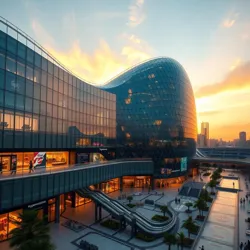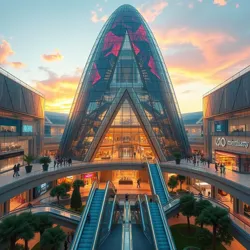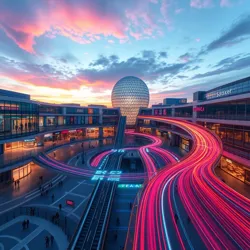Hyperwave Plaza
 The iconic quantum-glass facade of Hyperwave Plaza during its famous perpetual sunset phase
The iconic quantum-glass facade of Hyperwave Plaza during its famous perpetual sunset phaseHyperwave Plaza is a legendary quantum retail space that emerged during the Digital Commerce Revolution of 2091. Known for its revolutionary time-dilated shopping experiences and famous infinite escalator system, it became the premier destination for both physical and digital consumers seeking transcendent retail therapy.
History
Originally designed by renowned quantum architect Neo Valencia as an experiment in retail space-time manipulation, Hyperwave Plaza quickly evolved beyond its initial concept. The plaza's unique ability to exist simultaneously in multiple temporal frames made it a landmark achievement in commercial quantum architecture.
Architecture and Design
The plaza's most distinctive feature is its crystalline hyperstructure, which allows shoppers to experience multiple versions of the same store across different temporal planes. The central atrium, known as the "Eternal Court," features the famous Möbius Escalators that transport visitors through various shopping dimensions.
 A visualization of the plaza's unique time-dilated shopping spaces, showing multiple temporal layers
A visualization of the plaza's unique time-dilated shopping spaces, showing multiple temporal layersNotable Features
-
The Quantum Food Court, where meals exist in probability states until ordered
-
Schrödinger's Boutique, a shop that stocks all possible variations of an item simultaneously
-
The Vapor Gardens, where digital flora responds to consumer emotions
Cultural Impact
Hyperwave Plaza revolutionized digital retail by introducing several groundbreaking concepts:
-
Quantum loyalty programs that reward shoppers across multiple timelines
-
Probability-based pricing that fluctuates based on quantum observations
-
Memory-enhanced browsing that allows shoppers to experience products across all possible futures
 Heat map showing consumer movement patterns through various temporal layers of the plaza
Heat map showing consumer movement patterns through various temporal layers of the plazaLegacy
The success of Hyperwave Plaza led to the development of numerous similar quantum retail spaces, though none have achieved its perfect balance of temporal harmony and commercial viability. The plaza continues to serve as a model for advanced retail architecture and consumer experience design.
See Also
- Quantum Retail Theory
- Digital Commerce Revolution
- Temporal Shopping Dynamics
References
- The Hyperwave Chronicles
- Quantum Retail: A History
- Neo Valencia's Architectural Manifesto